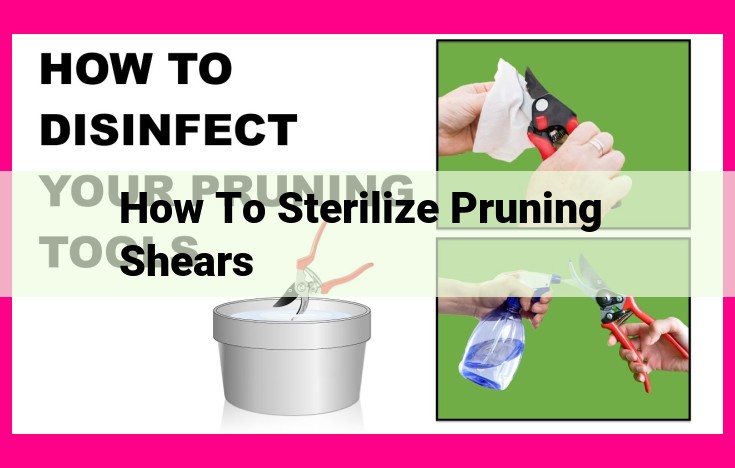Ultimate Guide: Sterilizing Pruning Shears To Prevent Plant Disease

To sterilize pruning shears, submerge them in a 10% bleach solution for 30 minutes, then rinse them thoroughly with water. Alternatively, you can boil them for 5 minutes or soak them in 70% isopropyl alcohol for 10 minutes. Always disinfect your shears before and after each use to prevent the spread of diseases among plants.
Horticultural Hygiene: The Key to Plant Health and Disease Prevention
Imagine your garden as a sanctuary for your precious plants. But just like our own health, the well-being of our greenery depends on good hygiene practices. Horticultural hygiene is the art of maintaining a clean and healthy environment for your plants, preventing the spread of diseases that can threaten their vitality.
Think of it this way: if we don’t wash our hands before touching food, we increase our risk of getting sick. Similarly, if we don’t take proper care of our gardening tools and surroundings, we inadvertently expose our plants to potential pathogens lurking in the dirt or on our equipment.
By implementing horticultural hygiene best practices, you can create a barrier against these unseen threats, ensuring that your plants thrive in a healthy and flourishing environment.
Pruning Best Practices: A Crucial Step for Plant Health and Disease Prevention
In the realm of gardening, proper pruning is not merely an act of shaping your plants but a vital measure for maintaining their health and preventing the onset of diseases. By carefully removing diseased or damaged branches and leaves, you create an environment that discourages the growth of harmful pathogens.
Choosing the Right Pruning Shears
The first step to effective pruning is selecting the appropriate shears. Sharp, well-maintained shears ensure clean cuts that minimize the risk of tearing or crushing plant tissue, providing entry points for disease. Always opt for shears that are designed specifically for pruning and handle them with care.
Disinfecting Pruning Tools
To further minimize disease transmission, it is essential to disinfect your pruning shears before and after each use. This prevents the spread of pathogens from one plant to another. Several methods are available for disinfection:
- Isopropyl alcohol (70% or higher): Wipe down the shears thoroughly with a cloth soaked in alcohol.
- Bleach solution (10% bleach to 90% water): Submerge the shears in the solution for 30 minutes, rinse thoroughly, and pat dry.
- Boiling water: Immerse the shears in boiling water for 30 seconds, then remove and allow to air dry.
- Autoclave: For hospitals or laboratories, an autoclave can sterilize shears at high temperature and pressure.
Disease Prevention in Plants: Maintaining a Healthy Garden
As avid gardeners, we pour our love and attention into nurturing our plants. However, lurking in the shadows are unseen foes that can threaten their well-being: plant diseases. Early detection and effective prevention measures are crucial to safeguard our verdant companions.
Common Plant Diseases and Their Symptoms
Plant diseases arise from various pathogens, including fungi, bacteria, viruses, and pests. Each pathogen has distinct symptoms, so recognizing them is vital for prompt intervention.
- Fungal Diseases: Look for signs of powdery mildew, rust, or leaf spots. Leaves may wither, curl, or develop brown or yellow patches.
- Bacterial Diseases: Wilt, soft rots, and blight are common bacterial infections. Plants may exhibit water-soaked lesions, yellowing leaves, or stunted growth.
- Viral Diseases: Mosaic patterns, yellow streaks, or stunted growth indicate viral infections. Viruses can spread rapidly and may cause severe damage.
Methods for Disinfecting Tools and Surfaces
To prevent disease transmission, it is essential to disinfect all tools and surfaces that come into contact with plants. This includes pruning shears, trowels, and even your hands. Here are effective disinfection methods:
- Isopropyl Alcohol: A 70% isopropyl alcohol solution is commonly used to disinfect small tools. Wipe down surfaces thoroughly and allow to air dry.
- Bleach Solution: A 10% bleach solution (1 part bleach to 9 parts water) can be used for larger surfaces like workbenches or plant containers. Rinse with clean water after application.
- Boiling Water: Submerging tools in boiling water for 10-15 minutes is an effective way to kill most pathogens.
- Autoclave: An autoclave, a specialized device used in laboratories and hospitals, is the most comprehensive method to sterilize tools and protect against all types of pathogens.
By implementing these disinfection practices, you can break the disease cycle and reduce the risk of infection in your garden.
Horticultural Hygiene Practices
Maintaining a healthy garden environment is crucial for disease prevention and promoting plant growth. Implementing horticultural hygiene practices can help you achieve this goal.
Maintaining Clean Growing Environments
- Regularly clean your gardening tools and equipment to prevent the spread of pathogens. Use a disinfectant solution and allow it to dry thoroughly before reuse.
- Keep your garden clean of fallen leaves, weeds, and other debris that can harbor insects and diseases.
- Regularly ventilate greenhouses to prevent excessive humidity and promote air circulation, reducing the risk of fungal growth.
Use of Soft Cloth or Paper Towels
Opt for soft cloths or paper towels when handling plants. These materials are less likely to spread diseases than rough or dirty materials.
Seeking Expert Advice
Don’t hesitate to consult experts for guidance on horticultural hygiene practices. Professional organizations like the American Society for Horticultural Science (ASHS) and local garden centers can provide valuable advice on specific plant care and disease prevention measures.
By adhering to these practices, you can create a healthy environment for your plants, minimize the risk of disease, and promote their lush growth and vitality. Remember, horticultural hygiene is an essential component of successful gardening, ensuring bountiful harvests and beautiful blooms for years to come.